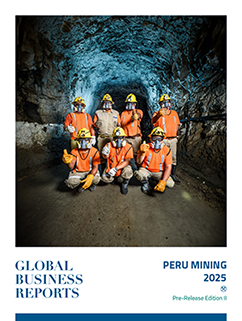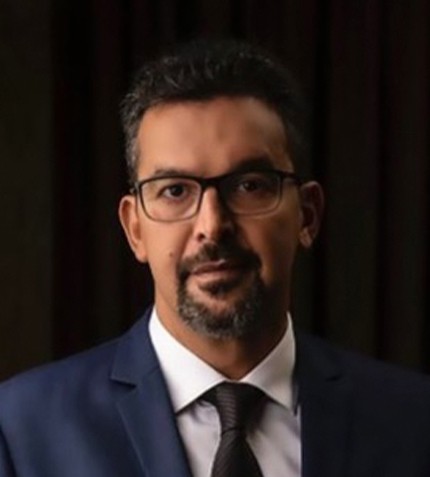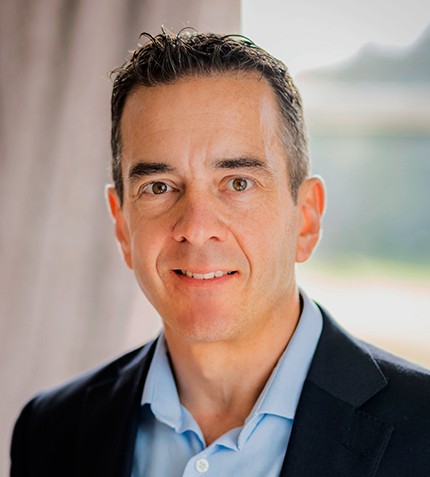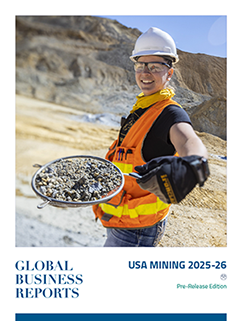Schedule is packed
RELATED PUBLICATION
ARTICLES FROM THIS PUBLICATION
Peru: Engineering, Consultancies and Contractors
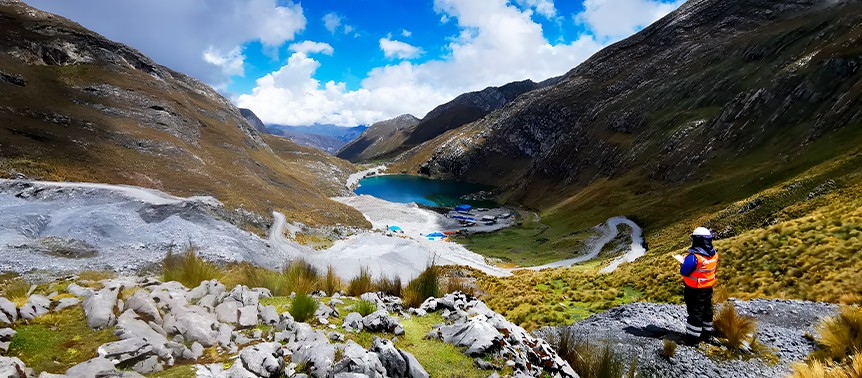
Image courtesy of Anddes
The buzz of activity in the mining industry during the final months of 2024 and the first quarter of 2025 has spread across the entire value chain, reaching well beyond producers. But what is keeping consulting and engineering houses so busy in Peru? It is certainly not a massive new mining project.
Open-pit projects such as Cerro Verde, Quellaveco and Antamina were capital-intensive and provided this segment with opportunities to grow due to the resources required. For example, Quellaveco's CapEx was US$5.5 billion; Cerro Verde, when it decided to expand its concentrator facilities to triple production from 120,000 t/d to 360,000 td/d, allocated a CapEx of around US$4.6 billion, along with another additional US$1 billion to build a new leach pad and SX/EW facilities. Antamina, for its part and more recently in 2023, announced a US$2 billion CapEx for its expansion.
Leaving aside Antamina's expansion, most of the more mature projects coming online today are not of that size. For instance, if we look closer at the most recent greenfield gold project coming online, Buenaventura's San Gabriel underground mine in Moquegua, we will see it has an estimated CapEx of US$650 million.
Another project in the same region and same size, though focused on copper and molybdenum, is Minera Hampton's Los Calatos. With production expected by 2029, it has an estimated CapEx of around US$700 million. This comparison, however, is not meant to diminish the significance of San Gabriel or Los Calatos. On the contrary, it is to highlight that even medium-size projects are crucial for a country that has not seen new projects since 2022, and their impact on the economy is still relevant. As Buenaventura's CEO, Leandro García, put it: "San Gabriel is the only greenfield project scheduled to begin production in 2025. It is not a Quellaveco, but that does not make it any less important—every project, no matter how small, adds value, especially when its reserves ensure continuity for the next 15 years."
Additionally, these projects serve as an opportunity for consulting and engineering firms to be more creative. As Gonzalo Morante, Walsh Peru's general manager, explained: "Large projects are more complex, because they must integrate multiple operations. Small and medium-sized projects, on the other hand, have limited budgets and require creative solutions to meet regulations and maintain high standards within established margins. Such creativity allows projects to be successful and helps set new industry standards."
The main revenue drivers for consultancies and engineering firms are currently brownfield projects and mine life extensions. "New mining projects, specifically greenfield projects, are somewhat of an outstanding issue in Peru. This is why, at present, our main projects are focused on sustaining existing ones," commented Javier Mendoza, general manager for Anddes Peru and Ecuador.
Sustainability
The general sentiment among consultancy and engineering firms has been positive in Peru, partly due to the bullish outlook markets have on metals. High prices immediately benefit producers, motivating them to maximize output, especially in Peru after the approval of Ministerial Resolution No. 125-2024-MINEM/DM, which amended Article 3 of Supreme Decree No. 030-2016-EM, allowing mining companies to ramp up production by 10% within existing capacity without requiring additional permits.
"When mineral prices rise, everyone rushes to take advantage of the peak in the cycle. The key is to act quickly and strategically to maximize profits before the market adjusts. This often means reevaluating processing rates and adjusting mining operations, which in turn drives demand for expansion and optimization studies—an area where we have seen significant growth," shared Christian Osorio, the general manager for Inti Mining Smart Solutions (IMSS).
Osorio added that the shift to a cleaner energy matrix is also driving demand for the company's service: "It is not just about extracting more, but about doing so more efficiently and sustainably, adapting to the new demands of the market and the environment."
María de Lourdes Bahía, VP of mining and metals and AtkinsRéalis, agreed: “Projects today are focused on reducing CO2 emissions and engaging with and benefiting communities. There is no demand for projects that do not care about their environmental and social footprint.”
“For example, we worked on a project where the pit was quite close to a group of houses. We suggested the client utilize acoustic barriers and dust suppressor equipment to minimize noise and powder emissions to the community.” added Daniel González, business development manager at AtkinsRéalis.
"The industry has seen protests about environmental contamination for decades, even where standards and results have improved. Climate change is a factor too. Across the length of the Andes, glaciers are melting – if a mine is in their vicinity, the likelihood that it will be blamed for their disappearance is high," commented Dan Etheredge, vice president and principal for Latin America at Klohn Crippen Berger (KCB), emphasizing that maintaining a good reputation is a constant challenge and that one misstep can overshadow years of hard work.
Walsh's general manager, Gonzalo Morante, believes that fresh approaches can help. To this end, the company has been undergoing a digitization process and integrating new talent with its experienced team: "This combination allows us to maintain a balance between price and quality. The new generations bring a fresh perspective and, with training, are more focused on environmental issues. What was once considered normal is no longer acceptable, and this presents challenges, especially in older mines where operations from the 1970s cannot be expected to meet current standards," he explained.
For Fernando Rodríguez, senior partner at Quarsus Consulting, investment in sustainability should be seen as a strategy to strengthen reputation and secure the industry's long-term future: "Minsur is the only Peruvian-owned mining company in the ICMM. Meeting these standards requires thorough assessments, investment and a shift in mindset."
EPCM
WSP's regional director for mining, Gustavo Bravo, and Peru's general manager, Virgilio Gonzales, highlighted how ESG has evolved: "The ESG agenda has become a cornerstone for the mining industry and WSP. It is no longer an emerging issue but an essential requirement, as reflected in studies on climate change, environmental monitoring, governance of tailings dams, water stewardship, energy and social diligence studies."
To continue adding value, WSP wants to diversify and venture into the EPCM sector without neglecting its core business: mining consulting. Its "Future Ready" program is at the heart of the company's sustainability and global growth strategy, intended to anticipate the future and identify new technologies. Gonzales continued: "Although the initial investment may depend on commodity prices, in the long term, these initiatives lead to a reduction in operational costs. Additionally, technologies like High-Density Sludge (HDS), help enhance safety, efficiency, and project operability, strengthening our commitment to a sustainable and profitable approach."
Amphos 21, a Spanish consultancy and engineering firm with deep knowledge of the whole water cycle, is also betting on the EPCM model. Miguel Mendoza, operations manager, explained: "From a strategic point of view, by getting involved in a mining operation with operational services we can tap into new opportunities to offer consulting on large-scale projects, which allows us to boost our sales."
Desalination for Peru
As has been a tradition at every PDAC that the Peruvian delegation attends, during Peru Day, the current Minister of Mines is one of the key speakers. This 2025, it was Minister Montero Cornejo's turn. After providing a general overview of the opportunities Peru has to offer from an energy-mining point of view, he moved on to topics that have long been featured in GBR's reports, such as dry tailings techniques, reuse of mining water, and the importance of easing tensions between the mining sector and society.
This year, Montero Cornejo invited the audience to explore the use of sea water, emphasizing that by desalinating water, the industry could take water off the negotiation table and preempt political slogans such as "water yes, gold no", previously used by anti-mining groups.
According to ACADES (the Chilean Desalination Association), Chile’s desalination capacity can provide 80% of the water required by the mining industry, a percentage that will increase to 85% in 2025. However, how feasible is this option for Peru?
Chile is narrow whereas Peru is wide, geographically rugged, and with operations above 3,000 m above sea level. "Water is a controversial topic in Peru, but there are already a few mining operations using desalinated water: Cerro Lindo, and Mina Justa. All of them are located close to the coast, which makes the process viable in terms of cost and efficiency. However, at 5,000 m above sea level, desalination is no longer a feasible option," stated Miguel Mendoza, operations manager at Amphos 21.
When comparing Chile's reality with Peru's, José Carlos De Piérola, country manager for Peru and Ecuador at ERM (Environmental Resources Management), noted that in the former, infrastructure is shared, while in the latter, mining companies tend to reject this model because they cannot control certain risks: "In Chile, desalination is the only viable option, that is why they have been successful at adopting it. However, Peru has other options, such as diverting water from the rainforest, but Peru has a poor management, especially when it comes to investing and maintaining existing infrastructure. Many reservoirs are already silted up, posing a serious risk in areas with heavy rainfall."
For Marcelo Caddeo, general director at Thiessen del Perú (TDP), the broader adoption of desalination in Peru could potentially boost the company's business there, as representatives of McElroy, a manufacturer of HDPE pipe fusion equipment: "Mines operate as hydraulic systems reliant on fluid movement. There are multiple projects in both Chile and Peru where we have supplied HDPE piping and desalination opens a major opportunity for us," he said.
Indeed, water is a controversial issue, especially in a country where mining and agriculture take place in close proximity. Tía María is one such case. Located above the Tambo Valley in southern Peru, it has long sparked conflict, with the slogan "Agro sí, minería no" ("Agriculture yes, mining no") becoming a rallying cry. Authorities, such as former minister Rómulo Mucho, have attempted to ease tensions by assuring the society that both industries can coexist. In fact, once operational, Tía María will use desalinated water.
While some consultancies are finding innovative ways to support desalination and cut water use, others are tackling challenges tied to tailings, with a different goal: "democratization".
That is the case with WWL (Water, Waste & Land). Roxana Ugaz, WWL's director, explained that the GISTM introduced rigorous standards that large mining companies can adopt thanks to their strong capital support, which not all mining companies have: "Through AI, we make the expertise of senior Engineering of Records - who may have over 40 years of experience - accessible without the need for constant on-site presence or disproportionate costs. This has opened up new opportunities and sub-services that allow us to stand out in the market," she added.
Big fish
"In 2024, we saw strategic moves with new acquisitions and alliances, highlighting how copper is essential for the energy transition and has become a strategic resource," commented Pamela Florian, country manager of Hatch.
High commodity prices are only rewarding when costs do not rise simultaneously. For Florian, Peru's copper industry is at a turning point where competition drives the need to boost productivity, improve efficiency, and reduce operational costs. "In a market where the 'big fish' are eating the smaller ones, every mining unit must become more efficient and competitive. Reducing delivery times and optimizing the supply chain directly impacts operational costs and enables companies to be more agile and better respond to market demands," she added.
Angie Sakata, Peru's recently appointed country manager at Stantec, pointed out that declining ore grades and other challenges make it difficult to maintain long-term sustainability goals: "We need a strategic approach that allows companies to capitalize on high prices without comprising the viability of their projects.”
For Lara Consulting, which specializes in designing, constructing, operating and closing tailings facilities, 2024 was an outstanding year according to its general manager, José Luis Lara: "We outperformed the sector, achieving 30% growth."
The company is now planning to launch a laboratory in Peru that will analyze and replicate the conditions of mining operations to develop innovative technologies for storing tailings with reduced water usage and help with the costs of operations. "The idea is to create an experimental space that focuses on the real needs of operators, something that is often missing in more specialized labs. […] We want this lab to serve as a hub for research and innovation, allowing us to develop our talent by attracting local and international projects and offering our clients safer and more cost-effective tailings facilities," Lara explained.
There is room for everyone
The Peruvian contractor segment is served by a mix of local and international companies, with new companies like Milicic and Construplan from Argentina and Mexico also entering the market.
For STRACON Group, Peru accounts for 40% of the company's activities. According to Steve Dixon, STRACON Group's CEO, Peru still offers plenty of room for growth: "We have a very robust backlog, of around two and a half times our annual sales, and so we are focused on performing for those clients […] Of course, we keep adding new clients too. In 2024, STRACON designed and built a water treatment plant at Cerro Corona for Gold Fields, and we have been working on Cerro Verde's new input crushing system. These are new services with new clients and part of our growth and diversification."
Grupo JJC is another Peruvian contractor that specializes in EPC projects. According to Sebastián Martin, the company's general manager, it is experiencing an exciting time: "Large-scale mining projects are coming back, with key projects such as the extension of Antamina's mine life, the return of Tía María, the launch of Zafranal, and new investments in Quellaveco. They are moving forward thanks to ongoing bidding processes, which are creating a sense of optimism across the sector."
Construplan has been working with Nexa Resources at the Atacocha and El Porvenir mines, which has allowed it to generate US$90 million in revenue. Rafael Ríos, Construplan's country manager, explained how Construplan adjusted its entry criteria to include more local talent and provided them with specialized technical training: "The challenge was not only technical but also strategic. We had to keep the corporate team calm amid an unprecedented situation when the project was halted by community blockades. This scenario demanded creativity, patience, and extraordinary effort. Without a doubt, it was an experience that left us with valuable lessons, a sense of satisfaction, and two years of work in Cerro de Pasco marked by a level of social peace that had not been seen in a long time."
According to Marian Milicic, general manager of Milicic, the Argentinian contractor focuses on medium-sized projects, often by partnering with Peruvian players: "We are already exploring some joint ventures with Peruvian companies, both larger and smaller than us, to complement our capabilities. We excel in earthworks and civil construction, while other companies focus on structural assembly. This allows our clients to have a full solution. We have always had a collaborative approach, which has been key to our growth in Argentina."
Alejandro Vásquez, commercial manager at Mur, noted that bidding processes have become more aggressive as the market becomes more dynamic: "We are taking advantage of all the opportunities emerging," commented Vásquez.
Underground contractors
As we get deeper into the value chain and it becomes more specialized, it is interesting to observe that while rising commodity prices increase the demand for studies from engineering and consultancy firms, the effect on more niche companies like underground contractors is less pronounced: "As a specialized company, we do not depend directly on commodity prices. For us, they are more of a reference point. Our focus has always been on delivering more value with the resources we have. Instead of solely focusing on price, we aim to do more with the same, or even less, ensuring that everything is done safely, with the highest quality possible," commented Guillermo San Miguel, AESA's CEO.
INCIMMET is another underground contractor whose CEO, Eduardo Cossio Chirinos, concurs: "Higher mineral prices have a positive impact, but it is marginal. A price increase can revive or boost the value of greenfield and brownfield projects, but that does not necessarily translate to better prices or margins for service providers […] Selling more does not necessarily mean higher profitability… Managing more or larger projects can mean hiring more people, which brings the labor shortage challenge. As a service provider, the real benefit comes from efficiency and maintaining a healthy project portfolio."
It seems that while high mineral prices are certainly beneficial, post-COVID inflation has driven up operational costs, especially salaries and equipment prices, which have led to adjustments in mining tariffs. "In Peru, the shotcrete market is small, with no more than 20 mines requiring it. That is why adaptability and efficiency are key to delivering sustainable solutions and expanding our services to other countries," explained Robocon's CEO, Enrique Sattler.
To remain flexible and competitive, Robocon manufactures its own shotcrete and narrow-vein equipment, custom-tailored to its clients' needs. "It allows us to optimize ground support in line with the production cycle and ensure safety and efficiency. We provide specialized compact equipment and concrete plants, but we also collaborate with leading suppliers to develop and improve conventional tools," Sattler concluded.
GEMIN Associates began as a consulting and engineering firm but identified a niche for growth as an underground contractor after working with Redpath on Newmont's Yanacocha Sulfuros project. According to Marco Zavala, the company's general manager, 2024 marked a turning point as GEMIN solidified its position in this segment through its work at Equinox Gold's Aurizona underground mine in Brazil. Throughout the year, the company focused on designing critical infrastructure, primarily ventilation and pumping systems. "This project strengthened our expertise in underground operations and built on our experience in Peru, where we have conducted inspections and designed vertical shaft extraction systems," Zavala explained.
Now, GEMIN wants to grow its geographical footprint in Central America, starting with Costa Rica.




